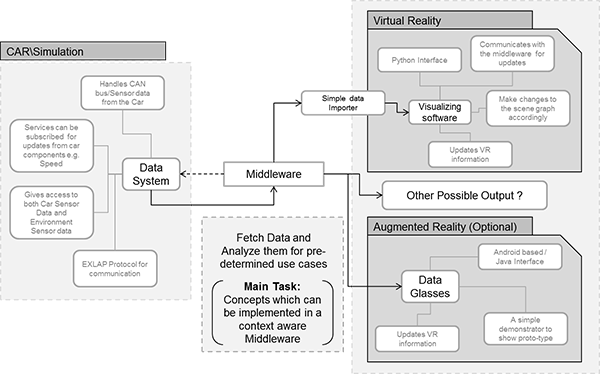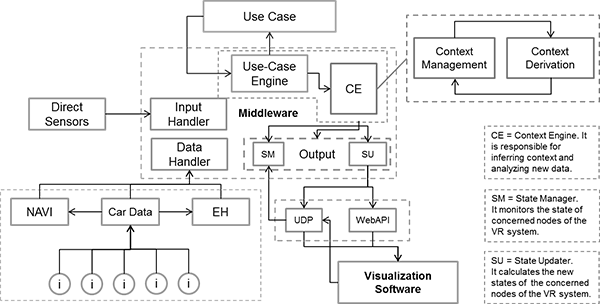An Intelligent Middle-ware for Prototyping Intuitive User-Experience in Cars

The thesis focuses on anaylsing and presenting vehicle data in a virtual scenario in near real time.
Description
Current advancements in the field of automotive development has equipped modern day cars with an array of sensors. These sensors which monitor vehicle parameters, generate huge amounts of data which are used by different modules to compute various vehicle situations. These modules deal with different aspects of the car and only work in their particular domains.
The thesis provides a comprehensive research on existing technologies and propose a prototype middleware which can connect to these modules, analyze all the available data, compute a virtual reality representation of the real car and its environment and finally visualize it in a virtual reality visualization software in near real-time. This prototype will allow developers to evaluate and rapidly prototype different ideas.
The middleware also provides an interface to all the data streams for contextual analysis and allows the developer to extend it to integrate use cases for future user experience development.
The thesis research was conducted in Volkswagen AG in Wolfsburg along with the University of Bremen under the supervision of Dr. Prof. Gabriel Zachmann (CGVR - University of Bremen), Dr. Prof. Lawo (TZI - University of Bremen), Dr. Johannes Tuemler (Volkswagen AG), Steven Benkhardt (Volkswagen AG) and Rony Garz (Volkswagen AG).

Results
The result of the thesis is a system which can make sense of the incoming sensor data and drive a virtual reality scenario based on it. The system also provides interface to this data stream for future development.
Files
Due to a Non-Disclosure Agreement the PDF of the thesis is only available on special request and subjected to approval by the concerned authorities.
License
This original work is copyright by University of Bremen.
Any software of this work is covered by the European Union Public Licence v1.2.
To view a copy of this license, visit
eur-lex.europa.eu.
The Thesis provided above (as PDF file) is licensed under Attribution-NonCommercial-NoDerivatives 4.0 International.
Any other assets (3D models, movies, documents, etc.) are covered by the
Creative Commons Attribution-NonCommercial-ShareAlike 4.0 International License.
To view a copy of this license, visit
creativecommons.org.
If you use any of the assets or software to produce a publication,
then you must give credit and put a reference in your publication.
If you would like to use our software in proprietary software,
you can obtain an exception from the above license (aka. dual licensing).
Please contact zach at cs.uni-bremen dot de.

